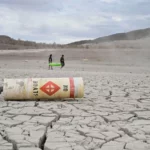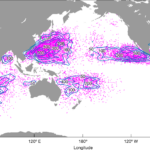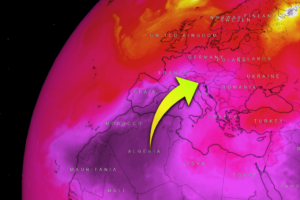Wildfires in Spain have forced more than 1,500 people to flee their homes and firefighters were still battling blazes in Valencia’s Castellon province into Sunday. More than 4,000 hectares of land have been engulfed by the fire.
This marked an early start to the country’s wildfire season amid dry conditions and high temperatures, which exceeded 30ºC in Valencia on Sunday.
“We’re looking at the first major fire, unfortunately, this year,” said Spanish Prime Minister Pedro Sánchez. “And it is also taking place out of season.”
Last year, Spain suffered nearly 500 wildfires that devastated huge swathes of land and upended lives.
Like much of Europe, the nation experienced record-high temperatures in 2022. Following a winter drought, these look set to continue into 2023.
What caused the recent wildfire in Spain?
The cause of the fire is still being investigated. Regional newspaper Las Provincias says police believe it may have originated with a spark from a machine used to collect brushwood.
Hot, dry weather conditions helped the fire to spread.
“The combination of high temperatures and west wind in recent weeks, with the lack of rain in recent months, has resulted in the topsoil being very dry in 100 per cent of the territory,” tweeted Valencia’s weather agency, AEMET, on Friday.
Temperatures were above 25ºC when the fire broke out, and relative humidity sank below 30 per cent following an unusually dry winter in the area.
500 firefighters supported by 20 planes and helicopters attempted to bring it under control near the village of Villanueva de Viver. Firefighters said such a blaze was more typical of summer than spring.
The fire was made more “voracious” by summer-like temperatures, according to Ximo Puig, president of the Valencia region.
March 2023 is shaping up to be Valencia’s second warmest on record since 2001.
Due to the extreme risk of forest fires in the region, it has been forbidden to start any kind of fire.
Is Spain’s heatwave a result of climate change?
As our climate warms, wildfires are burning more frequently and intensely. They are also starting earlier in the season, as seen in Spain.
Like much of Europe, Spain has experienced a hot, dry winter.
If the country faces “another summer in which temperatures don’t fall below 35C for 20 days and it doesn’t rain for four months, the vegetation will be liable to go up in flames” with the first lightning bolt, warns wildfire expert Pablo Martin Pinto.
Greenhouse gases released by human activity are causing global temperatures to spike. Like glass in a greenhouse, CO2, methane, nitrous oxide and other gases trap the sun’s heat, causing less warmth to return to space.
The concentration of CO2 in the atmosphere soared by 48 per cent between 1750 to 2020, according to the European Commission.
The planet’s average temperature has risen by 1.1C since pre-industrial levels.
Global warming also increases evaporation on land, which can worsen drought, create conditions more prone to wildfire, and lead to a longer wildfire season.
Are wildfires getting worse in Spain?
In 2022, 306,000 hectares were lost to wildfires in Spain. This was more than three times as much as the previous year, according to Statistica. The country’s worst blaze devastated 60,000 hectares of Sierra de la Culebra in the northwest.
Pinto says that the fires were caused by “extraordinary atmospheric situations” triggered partly by the effects of climate change. Such conditions are likely to become more frequent, he adds.

“We are moving from the era of big forest fires to mega forest fires in Spain,” says the Valladolid University professor, warning that such vast blazes were “here to stay”.
Not only do fires destroy land and homes, they expose people to dangerous levels of air pollution. Smoke particles including carbon monoxide can spread thousands of kilometres, causing respiratory issues, headaches and nausea.
High-intensity fires can also damage soil, causing erosion, reducing nutrients and preventing water absorption. This all leads to biodiversity loss.
How can we reduce the risk of wildfires?
Experts say conserving Spain’s forests is key to addressing the risk of wildfires.
The forests “must be protected” by looking after the undergrowth that can generate wildfires, says Jose Angel Arranz Sanz, forestry policies director in the Castilla y Leon region.
Pinto advocates the creation of areas which are “more resilient” featuring a varied “patchwork landscape” made up of “wooded forest areas… and livestock farms, interspersed with areas of scrubland”.
Where forested landscapes are more homogenous, “it really limits the ability to stop a fire from spreading,” he warns.
Forest ranger Jorge de Dios, who represents a regional environmental workers union, says more resources are needed, warning of a lack of firefighters who are trained to tackle such situations.
“We are going to see more and more fires, and bigger ones,” he said, saying most local firefighters “are not professionals and don’t have enough training,” echoing concerns also raised by regional firefighters.
Greenpeace also urged the authorities to adopt a new approach focusing on early preemptive action to minimise the risks.
“Wildfires must be at the top of the political agenda and shouldn’t be tackled only when there is heat and fire, but by early preventative action with appropriate environmental management tailored to this new reality,” says Monica Parrilla of Greenpeace Spain.
Source : Euro News











Add Comment